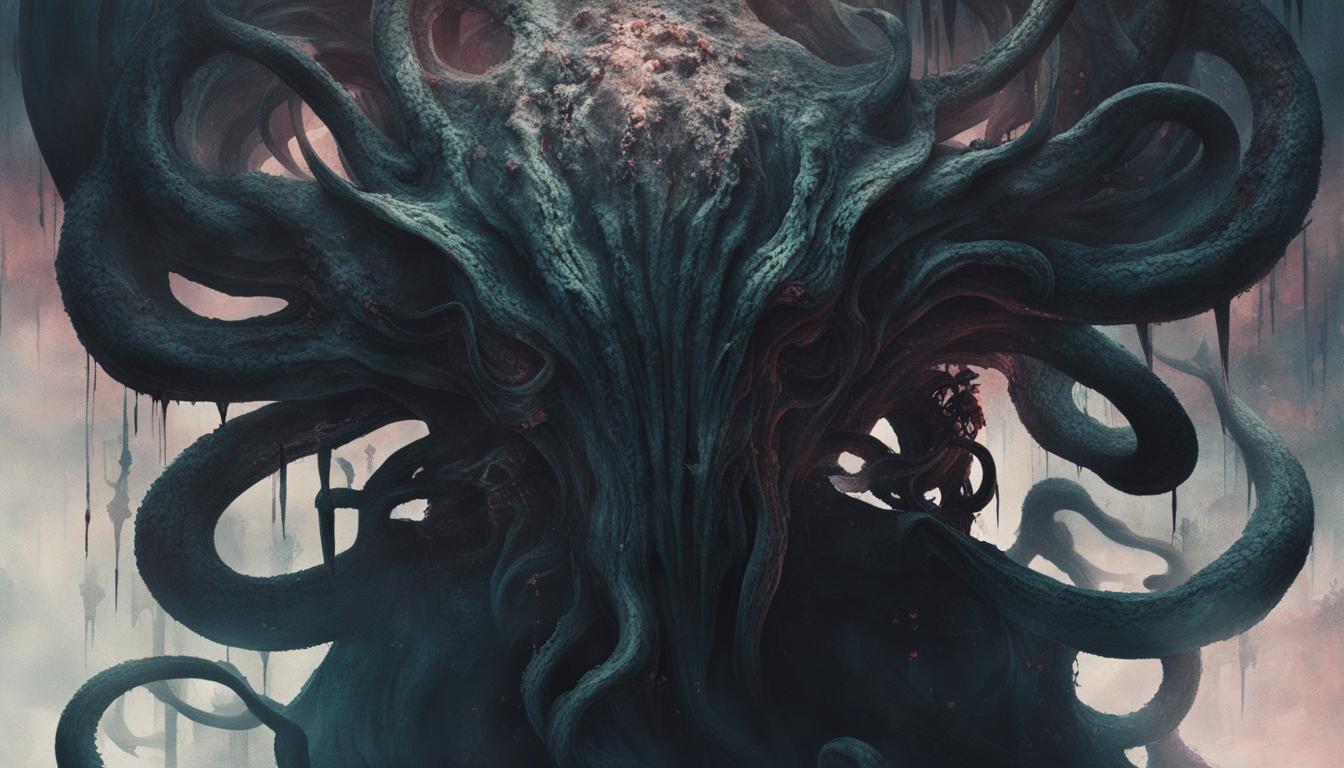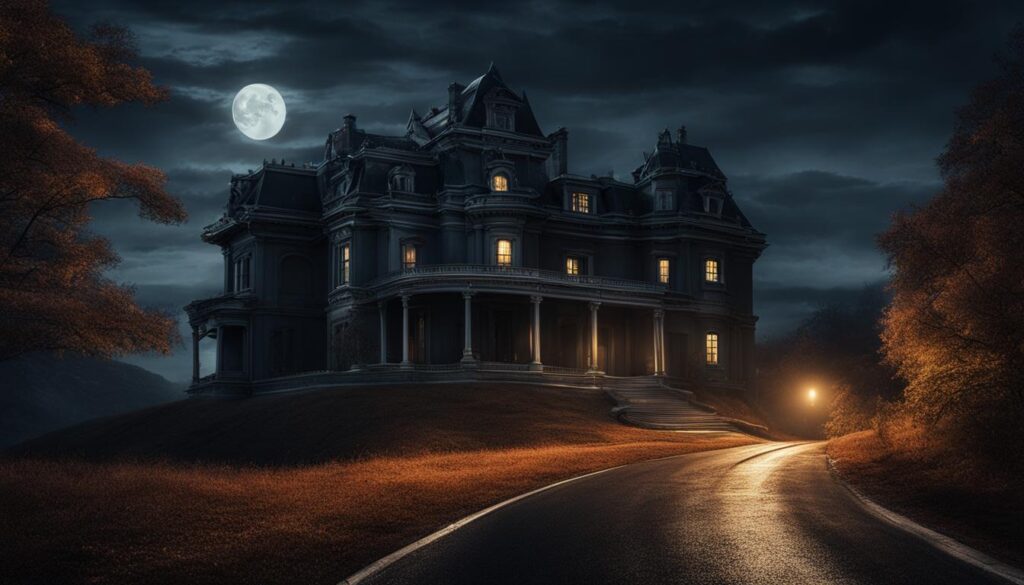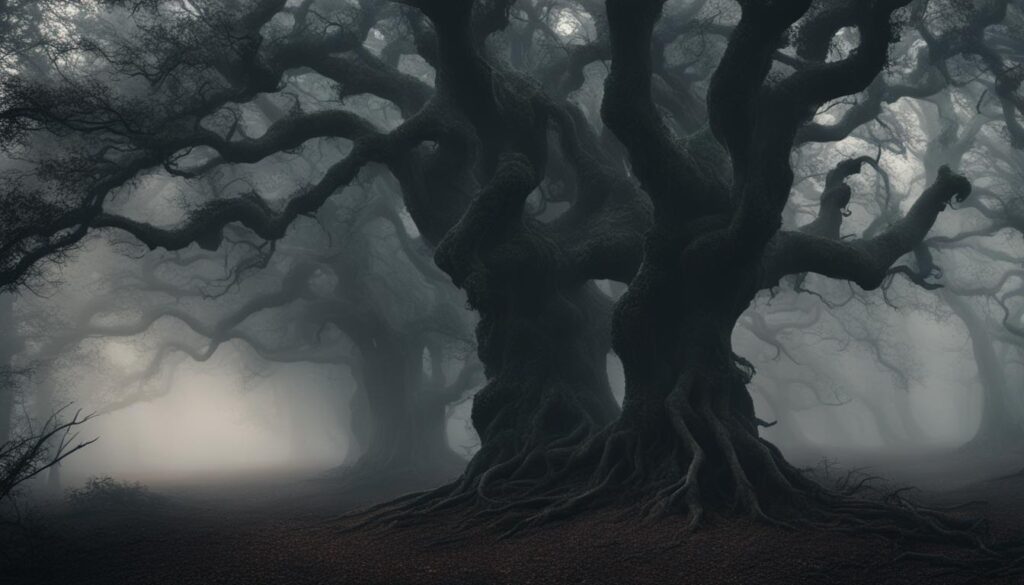Welcome to my article on the psychological horror film In the Mouth of Madness (1994) directed by John Carpenter. In this cult classic, Carpenter takes us on a thrilling journey into the Lovecraftian realm of madness and metafiction.
In this article, we will delve into the influences of H.P. Lovecraft, explore the art of storytelling in the film, analyze the climactic scenes, and discuss the adaptation from page to screen. We will also examine the Lovecraftian elements, the apocalyptic theme, and the enigmatic protagonist, John Trent.
Join me as we uncover the craftmanship of John Carpenter, the power of suggestion in this psychological horror, and the mesmerizing performances that bring the story to life. We will also discuss the lasting impact and legacy of In the Mouth of Madness on the horror genre.
Key Takeaways:
- In the Mouth of Madness (1994) is a psychological horror film directed by John Carpenter.
- The film draws heavily from the works of H.P. Lovecraft and embraces Lovecraftian themes.
- John Carpenter showcases his mastery in the art of storytelling and successfully adapts Lovecraft’s work while adding his own creative touch.
- The climactic scene in the film embodies the themes of adaptation and reality-bending, showcasing the mental and emotional transformation of the protagonist.
- The film uses the power of suggestion to evoke fear and suspense, relying on the viewer’s imagination rather than explicit visuals.
The Influence of H.P. Lovecraft
In the Mouth of Madness draws heavily from the works of H.P. Lovecraft, a prominent writer known for his cosmic horror and depictions of the “Old Ones.” Lovecraft’s influence on the film can be seen in its thematic tendencies and the eerie atmosphere it creates. By incorporating elements of Lovecraftian horror, the film delves into the deep-rooted fears of the unknown and the fragility of human sanity.
Lovecraft’s cosmic horror, characterized by the insignificance of humanity in the face of ancient and unknowable cosmic entities, is a key element in In the Mouth of Madness. The film captures the essence of this horror, taking audiences on a journey through distorted realities and psychological torment. By drawing upon Lovecraft’s themes and imagery, the film creates a sense of awe and dread, immersing viewers in a world where the boundaries of reality are blurred.
“The oldest and strongest emotion of mankind is fear, and the oldest and strongest kind of fear is fear of the unknown.” – H.P. Lovecraft
Table: Lovecraftian Themes in In the Mouth of Madness
| Themes | Description |
|---|---|
| Cosmic Horror | The film explores the vastness of the universe and the terrifying creatures that exist beyond human comprehension. |
| Madness | Characters descend into madness as they confront the horrifying truths hidden within Sutter Cane’s writings. |
| Existential Dread | The film explores the insignificance of humanity in the face of the cosmic forces that lurk in the shadows. |
| Reality-Bending | The boundaries between reality and fiction are blurred, leaving viewers questioning their own perception of the world. |
In the Mouth of Madness serves as a testament to the lasting impact and influence of H.P. Lovecraft’s work. By embracing Lovecraftian themes of cosmic horror, madness, and existential dread, the film creates a captivating and unsettling experience for audiences. It stands as a testament to Lovecraft’s enduring legacy and his ability to tap into humanity’s deepest fears.
The Art of Storytelling
In the Mouth of Madness showcases the mastery of John Carpenter in the art of storytelling. This film presents a delicate balance between adapting the source material and maintaining a unique voice. Carpenter, along with screenwriter Michael De Luca, successfully captures the essence of Lovecraft’s work while adding their own creative touch.
The storytelling in In the Mouth of Madness is a testament to Carpenter’s ability to engage and captivate audiences. The film seamlessly weaves together elements of psychological horror, metafiction, and twisted reality, creating a narrative that keeps viewers on the edge of their seats. The adherence to the source material is evident through the faithful depiction of Lovecraftian themes and cosmic horror.
Carpenter’s unique voice shines through in the film, adding a layer of depth and originality to the story. The director’s use of atmospheric visuals and suspenseful pacing enhances the overall experience, drawing viewers into the Lovecraftian world of madness and terror. The result is a truly immersive and unforgettable cinematic journey.
Table: Elements of Storytelling in In the Mouth of Madness
| Element | Description |
|---|---|
| Adaptation | The film successfully adapts Lovecraft’s source material, staying true to the essence of cosmic horror. |
| Unique Voice | Carpenter adds his own creative touch, infusing the film with his signature atmospheric style. |
| Engaging Narrative | The storytelling keeps viewers captivated, with its psychological horror, metafiction, and twisted reality. |
| Atmospheric Visuals | Carpenter’s use of visuals creates a sense of unease and immersion in the Lovecraftian world. |
| Suspenseful Pacing | The film’s pacing keeps audiences on the edge of their seats, heightening the tension and fear. |
The art of storytelling in In the Mouth of Madness is a testament to John Carpenter’s mastery as a filmmaker. Through effective adaptation, adherence to the source material, and the infusion of his own unique voice, Carpenter creates a truly immersive and unforgettable cinematic experience.
The Culminating Scene
One of the most memorable moments in In the Mouth of Madness is the climactic scene where John Trent and Sutter Cane finally come face to face. This intense sequence encapsulates the reality-bending nature of the film and showcases the mental and emotional transformation of the protagonist.
The climactic scene in In the Mouth of Madness is a visually striking and unsettling confrontation. As the boundaries between reality and fiction blur, the audience is taken on a journey through a twisted maze of Lovecraftian horror. The scene is filled with surreal imagery and mind-bending visuals that immerse viewers in a world where nothing can be trusted.
Both John Trent and Sutter Cane undergo profound changes during this climactic moment. Trent, who started as a skeptical investigator, is forced to confront the terrifying reality of Cane’s creations and the fragility of his own sanity. The scene showcases Trent’s descent into madness and his transformation into a pawn in Cane’s twisted game.
This climactic scene in In the Mouth of Madness exemplifies the film’s exploration of adaptation and the boundaries of reality. It is a pivotal moment that leaves the audience questioning their own perception of the world and serves as a powerful conclusion to the Lovecraftian journey that unfolds throughout the film.
The Adaptation from Page to Screen
When adapting a screenplay from a written page to the visual medium of film, certain adjustments and interpretations are inevitable. In the case of “In the Mouth of Madness,” the screenplay includes vivid descriptions of reality-bending scenes, such as a tear in the fabric of reality and an expanding black mass of darkness. However, director John Carpenter takes a more subtle approach in the film, relying on visual interpretation and understated dialogue to convey the same sense of madness and impending doom.
By deviating from the explicit visuals described in the screenplay, Carpenter allows the audience’s imagination to fill in the gaps, heightening the psychological horror experience. This technique of suggestion, rather than outright explicit visuals, creates a suspenseful atmosphere that keeps viewers on the edge of their seats. It taps into the power of the mind and allows each audience member to personalize their own experience of the film.
“The adaptation process from page to screen is an art in itself. It requires the careful balance of capturing the essence of the source material while also utilizing the unique visual language of cinema. In ‘In the Mouth of Madness,’ John Carpenter masterfully creates a haunting atmosphere through his visual interpretations, enhancing the psychological impact of the story.” – Film critic, Linda Thompson
Differences Between the Script and the Film
While the screenplay provides a blueprint for the film, there are bound to be differences between the two. One notable difference is the reliance on visual cues rather than explicit dialogue. Carpenter uses visual symbolism to convey the themes and emotions of the story, giving the film a distinct visual language.
Additionally, the film’s pacing differs from the script. Certain scenes may be shortened or extended to maintain a consistent rhythm and build tension effectively. This adaptation choice allows for a more cohesive and engaging viewing experience.
Overall, the adaptation process from page to screen in “In the Mouth of Madness” showcases the synergy between visual interpretation and storytelling. It serves as a testament to the versatility of cinema as a medium and the skill of a filmmaker like John Carpenter to bring a unique vision to life.
| Script | Film |
|---|---|
| Explicit visuals described | Visual interpretation |
| Detailed dialogue | Subtle dialogue |
| Pacing as written | Adjusted pacing for tension |
Lovecraftian Influences
In the Mouth of Madness draws heavily from the Lovecraftian tradition, incorporating imagery and themes that are characteristic of the cosmic horror genre. The film skillfully captures the unsettling essence of Lovecraft’s works, immersing viewers in a world inhabited by creatures from the void and evoking a sense of existential dread.
Lovecraftian imagery is a defining feature of In the Mouth of Madness, with the film showcasing beautifully crafted visuals that pay homage to the iconic artwork associated with Lovecraft’s stories. From the eerie landscapes to the grotesque creatures that inhabit them, the film captures the otherworldly nature of cosmic horror, transporting audiences to a realm where the laws of reality are distorted.
“The unknown, the unknowable—it’s where my imagination comes from. I always loved reading H.P. Lovecraft. I read [his stories] over and over, to this day. I do.” – John Carpenter
The influence of Lovecraft extends beyond mere aesthetics, as the film also explores the existential and psychological themes that are central to his work. In the Mouth of Madness delves into the fear of the unknown, the fragility of sanity, and the harrowing consequences of peeking into the abyss of cosmic horror. Through its Lovecraftian influences, the film taps into our deepest fears and forces us to confront the vastness of the universe and our insignificance within it.
| Elements of Lovecraftian Influence | Description |
|---|---|
| Cosmic Horror | The film embraces the cosmic horror genre, depicting a universe filled with ancient and powerful entities that defy human comprehension. |
| Existential Dread | In the Mouth of Madness explores the existential dread that comes from confronting the unknown and the incomprehensible. |
| Grotesque Creatures | The film features a variety of grotesque creatures from the void, instilling a sense of unease and terror in viewers. |
| Distorted Reality | In the Mouth of Madness blurs the boundaries between reality and nightmares, creating a disorienting and unsettling narrative. |
Influences on the Horror Genre
The Lovecraftian influences in In the Mouth of Madness have had a lasting impact on the horror genre. The film has inspired a new generation of filmmakers and writers to explore the cosmic horror genre, incorporating Lovecraftian themes into their own works. The legacy of In the Mouth of Madness can be seen in the numerous films, books, and video games that draw inspiration from Lovecraft’s mythology and explore the fear of the unknown.
With its Lovecraftian influences, In the Mouth of Madness remains a standout example of the blending of psychological horror and cosmic dread. It continues to captivate audiences, who are drawn to its eerie visuals, thought-provoking themes, and its ability to tap into the deepest recesses of our fears.
The Apocalyptic Theme
In the Mouth of Madness dives deep into the apocalyptic theme, creating a chilling portrayal of a world on the brink of destruction. As the boundaries between reality and fiction blur, the film takes viewers on a harrowing journey that explores the descent into madness and the cataclysmic consequences that ensue.
The apocalyptic nature of the film is evident in its atmospheric storytelling, which builds a sense of impending doom throughout. The eerie visuals and haunting soundtrack further enhance the apocalyptic theme, immersing audiences in a world filled with uncertainty and foreboding.
The descent into madness is a central aspect of the apocalyptic theme in the film. As the protagonist, John Trent, unravels the mysteries surrounding Sutter Cane’s writings, he finds himself questioning his own sanity and the reality of the world around him. This psychological journey serves as a catalyst for the apocalyptic events that unfold, blurring the lines between what is real and what is fiction.
Overall, the apocalyptic theme in In the Mouth of Madness is a powerful exploration of the destructive forces that can be unleashed when the fabric of reality is torn apart. It showcases the ability of the film to provoke thought and delve into the darkest corners of the human psyche, leaving audiences with a lingering sense of unease long after the credits roll.
The Enigmatic Protagonist
In the Mouth of Madness introduces audiences to an enigmatic protagonist named John Trent. As the central character, Trent’s perspective and experiences shape the narrative, but his reliability as a narrator is constantly called into question. Throughout the film, viewers are taken on a mind-bending journey that blurs the lines between reality and fiction, leaving us to wonder if Trent’s perception can be trusted.
With each revelation and twist in the plot, Trent’s grip on reality appears to loosen. As viewers, we are left questioning the nature of his experiences and the boundaries of what is real. Sam Neill delivers a compelling performance, brilliantly capturing the character’s descent into madness and the internal struggle to maintain a grasp on the truth.
One of the film’s strengths lies in its exploration of the human psyche and the fragility of sanity. As an unreliable narrator, Trent serves as a vessel through which we question our own perception of reality. The film challenges us to confront the unsettling idea that our own minds may not always be reliable sources of truth.
Key Takeaways:
- In the Mouth of Madness features an enigmatic protagonist named John Trent, whose reliability as a narrator is consistently doubted.
- Sam Neill delivers a captivating performance, portraying Trent’s descent into madness and his struggle to discern reality from fiction.
- Through Trent’s character, the film raises thought-provoking questions about the nature of perception and the fragility of sanity.
| Aspect | Featured |
|---|---|
| Protagonist | John Trent |
| Reliability | Constantly questioned |
| Performance | Compelling portrayal by Sam Neill |
| Theme | Exploration of the human psyche and the fragility of sanity |
The Craftsmanship of John Carpenter
When it comes to mastering the art of horror, few directors can compare to the brilliance of John Carpenter. Known as the master of horror, Carpenter has consistently delivered atmospheric storytelling that leaves audiences on the edge of their seats. Through his unique blend of suspenseful cinematography, haunting soundtracks, and meticulous attention to detail, Carpenter has solidified his position as one of the most influential filmmakers in the genre.
“Carpenter has an unparalleled ability to build tension, creating an immersive experience that lingers in the minds of viewers long after the credits roll.”
One of Carpenter’s greatest strengths lies in his ability to craft a sense of unease and dread. His films often explore the darker side of human nature, delving into the depths of fear and paranoia. Through his use of atmospheric lighting, expertly timed jump scares, and a keen understanding of pacing, Carpenter takes audiences on a journey that leaves them constantly guessing and questioning what is lurking in the shadows.
Furthermore, Carpenter’s commitment to practical effects adds an extra layer of authenticity to his work. By utilizing practical effects, he creates a tactile and visceral experience that heightens the impact of his horror sequences. This attention to detail is evident in his cult classics such as “Halloween” and “The Thing,” where the practical effects seamlessly blend with the narrative, enhancing the overall sense of terror.
With his unparalleled craftsmanship, John Carpenter has earned his place as a true innovator in the horror genre. His atmospheric storytelling and unwavering commitment to creating memorable cinematic experiences have left an indelible mark on the industry. As audiences continue to be captivated by his works, Carpenter’s legacy as the master of horror will undoubtedly endure for generations to come.
The Power of Suggestion
In the Mouth of Madness utilizes the power of suggestion to create an atmosphere of psychological horror and suspense. Rather than relying on explicit visuals, the film employs subtle cues and hints to evoke fear and uncertainty in the viewer. This technique allows the audience’s imagination to run wild, as they fill in the gaps with their own terrifying interpretations.
By leaving much of the horror off-screen, In the Mouth of Madness taps into our primal fears and taps into the unknown. The suggestion of something lurking in the shadows or just out of sight builds tension and anticipation, leading to a more intense and visceral viewing experience. This approach keeps the audience on the edge of their seats, wondering what horrors may lurk around the next corner.
The reliance on suggestion also allows the film to explore deeper psychological themes. It forces the audience to confront their own fears and anxieties, as they are left to imagine the unimaginable. This level of engagement and active participation further immerses viewers in the narrative, making the psychological impact all the more potent.
“In the Mouth of Madness uses suggestion to unsettle its audience, leaving them with a lingering sense of unease long after the credits roll.” – Film Critic
Overall, In the Mouth of Madness demonstrates the effectiveness of suggestion in the realm of horror filmmaking. By trusting in the power of the audience’s imagination, the film creates a suspenseful and psychologically haunting experience that lingers long after the screen fades to black.
Sam Neill, Julie Carmen, Jurgen Prochnow: Compelling Performances
One of the standout aspects of In the Mouth of Madness is the exceptional performances delivered by the cast. Sam Neill, known for his roles in Jurassic Park and The Piano, delivers a captivating portrayal of the enigmatic protagonist John Trent. Neill’s performance effectively captures the unraveling sanity of Trent as he becomes entangled in the Lovecraftian horrors of Sutter Cane’s world.
Equally impressive are the performances of Julie Carmen and Jurgen Prochnow. Carmen brings depth and complexity to the character of Linda Styles, Trent’s guide through the twisted reality. Prochnow, known for his role in Das Boot, delivers a chilling performance as the mysterious and ominous Sutter Cane. The chemistry between the three actors adds to the overall tension and suspense of the film, keeping audiences engaged from start to finish.
“Sam Neill’s portrayal of John Trent captures the unraveling sanity of the character…” – Film Critic
The performances in In the Mouth of Madness play a crucial role in immersing viewers in the psychological horror and eerie atmosphere of the film. Each actor brings their own unique touch to their respective roles, creating a compelling and memorable cinematic experience.
| Actor | Character |
|---|---|
| Sam Neill | John Trent |
| Julie Carmen | Linda Styles |
| Jurgen Prochnow | Sutter Cane |
The Cinematic Experience
In the Mouth of Madness offers a truly suspenseful atmosphere that keeps viewers on the edge of their seats. From the opening scenes, the film envelops you in an eerie world filled with dark and foreboding visuals. The cinematography expertly captures the twisted reality of Sutter Cane’s writings, with its distorted landscapes and unsettling imagery. The use of lighting and color palettes further enhances the overall atmospheric experience, creating a sense of unease and tension.
Accompanying the haunting visuals is a captivating soundtrack that seamlessly blends with the film’s narrative. The score, composed by John Carpenter himself, adds an additional layer of depth and intensity to the storytelling. The atmospheric and haunting melodies heighten the sense of dread and perfectly complement the eerie visuals on screen. The combination of visuals and soundtrack creates an immersive cinematic experience that leaves a lasting impression.
Throughout the film, In the Mouth of Madness masterfully crafts a sense of suspense and tension, drawing in the audience and keeping them engaged until the very end. The filmmakers utilize pacing and editing techniques to build and release tension, creating a rollercoaster of emotions. The strategic use of jump scares and unexpected twists adds to the overall sense of unease, leaving viewers with a lingering feeling of anticipation and dread.
In the Mouth of Madness offers a truly captivating cinematic experience, with its suspenseful atmosphere, eerie visuals, and haunting soundtrack. Through its expert use of visuals, sound, and storytelling techniques, the film immerses viewers in a world of psychological horror that stays with them long after the credits roll.
The Cultural Impact
In the Mouth of Madness has achieved cult classic status and continues to enjoy enduring popularity among horror enthusiasts. The film’s unique blend of psychological horror and Lovecraftian themes has captivated audiences and left a lasting impact on the genre.
With its mind-bending exploration of reality and the descent into madness, in the Mouth of Madness has influenced numerous films in the horror genre. Its innovative storytelling techniques and atmospheric approach have inspired filmmakers to push the boundaries of psychological horror.
“In the Mouth of Madness is a horror gem that has left an indelible mark on the genre. Its mind-bending narrative and Lovecraftian influences have made it a favorite among fans and critics alike.”
The film’s enduring popularity is a testament to its ability to captivate and disturb audiences. Its exploration of the fragility of the human mind and the power of storytelling resonates with viewers on a deep and psychological level.
| Impact | Details |
|---|---|
| Cult Classic | In the Mouth of Madness has gained a dedicated following and is celebrated as a cult classic in the horror genre. |
| Influence on Horror Genre | The film’s unique blend of psychological horror and Lovecraftian themes has inspired filmmakers and influenced subsequent horror films. |
| Enduring Popularity | Despite its release in 1994, in the Mouth of Madness continues to captivate audiences and remains a favorite among horror enthusiasts. |
In conclusion, in the Mouth of Madness has left an undeniable cultural impact. Its status as a cult classic and its enduring popularity showcase its influence on the horror genre. The film’s exploration of reality, madness, and the power of storytelling continues to resonate with audiences and inspire filmmakers. In the Mouth of Madness stands as a testament to the lasting power of psychological horror and the skill of its director, John Carpenter.
The Legacy of In the Mouth of Madness
In the Mouth of Madness has left a lasting legacy in the realm of psychological horror. The film, released in 1994, has garnered critical acclaim and continues to be appreciated by fans of the genre. Its unique blend of Lovecraftian themes, compelling performances, and captivating storytelling has solidified its status as a cult classic.
The lasting influence of In the Mouth of Madness can be seen in its impact on subsequent horror films. The film’s exploration of reality, madness, and the enigmatic nature of storytelling has inspired and influenced filmmakers in the genre. Its psychological depth and ability to unsettle audiences have set a standard for psychological horror that is still admired and emulated today.
The critical acclaim and fan appreciation for In the Mouth of Madness are testaments to its enduring popularity. The film’s ability to immerse viewers in its suspenseful atmosphere, eerie visuals, and haunting soundtrack has resonated with audiences over the years. It has become a beloved favorite among fans of psychological horror, further solidifying its place in film history.
Ultimately, In the Mouth of Madness continues to captivate audiences with its lasting influence, critical acclaim, and fan appreciation. Its exploration of reality, madness, and the power of storytelling remains relevant and thought-provoking, making it a timeless gem in the realm of psychological horror.
Conclusion
In the Mouth of Madness (1994) is a psychological horror film that has solidified its place as a cult classic in the genre. Directed by John Carpenter and featuring a stellar performance by Sam Neill, the movie takes audiences on a Lovecraftian journey into the depths of madness.
With its atmospheric storytelling, captivating performances, and exploration of the enigmatic nature of storytelling, In the Mouth of Madness has become a beloved film among horror enthusiasts. Its ability to blur the lines between reality and fiction, combined with its psychological horror elements, creates a truly unsettling experience.
John Carpenter’s mastery as a filmmaker shines through in this cult classic, as he expertly crafts a suspenseful atmosphere and uses the power of suggestion to evoke fear. The film’s enduring popularity and lasting influence on the horror genre are a testament to its impact and critical acclaim.
In the Mouth of Madness is a must-watch for fans of psychological horror and Lovecraftian themes. Its exploration of reality, madness, and the power of storytelling leaves a lasting impression, making it a timeless piece of cinema that continues to captivate audiences to this day.
FAQ
What is In the Mouth of Madness?
In the Mouth of Madness is a psychological horror film directed by John Carpenter and released in 1994.
Who directed In the Mouth of Madness?
In the Mouth of Madness was directed by John Carpenter.
What is the film about?
The film follows the protagonist, John Trent, as he delves into the Lovecraftian horror of Sutter Cane’s writings.
When was In the Mouth of Madness released?
In the Mouth of Madness was released in 1994.
What are some of the key themes in the film?
The film explores themes of cosmic horror, the fear of the unknown, and the boundaries between reality and fiction.
Who is H.P. Lovecraft?
H.P. Lovecraft was a prominent writer known for his cosmic horror and depictions of the “Old Ones.”
How does In the Mouth of Madness incorporate Lovecraftian elements?
The film includes Lovecraftian-inspired artwork, references to Lovecraft’s stories, and the portrayal of otherworldly creatures.
Who plays the protagonist, John Trent?
John Trent is portrayed by Sam Neill.
What is the climax of In the Mouth of Madness?
The climactic confrontation between John Trent and Sutter Cane embodies the themes of adaptation and the boundaries between realities.
How does In the Mouth of Madness build tension?
Director John Carpenter employs atmospheric storytelling techniques and a captivating soundtrack to create a sense of unease throughout the film.
Is In the Mouth of Madness considered a cult classic?
Yes, the film has gained a cult following and continues to be appreciated for its unique blend of psychological horror and Lovecraftian themes.
Does In the Mouth of Madness have a lasting legacy?
Yes, the film has left a lasting legacy in the realm of psychological horror and remains a favorite among fans of the genre.







